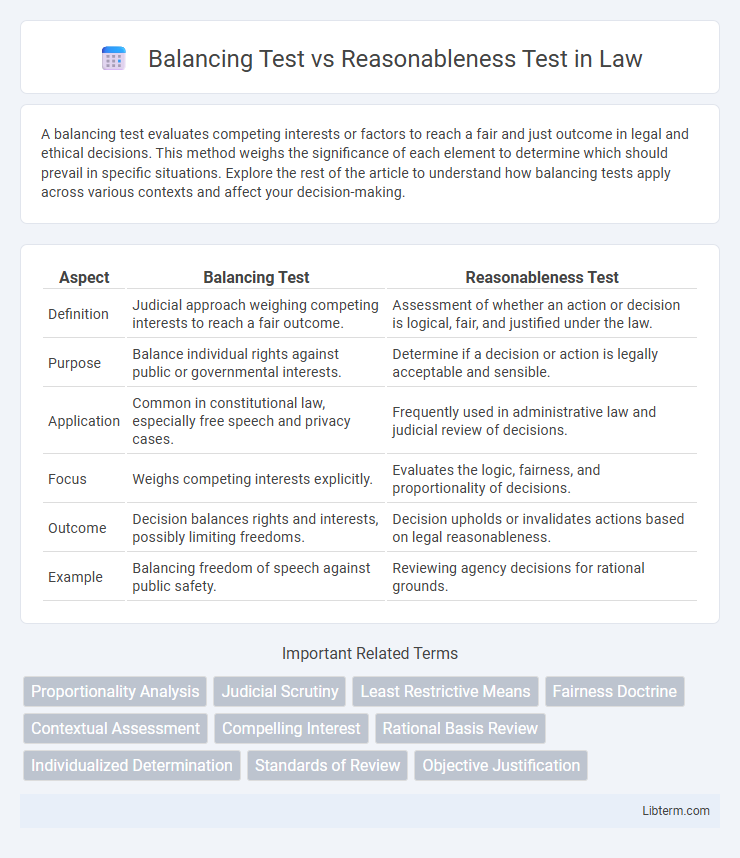A balancing test evaluates competing interests or factors to reach a fair and just outcome in legal and ethical decisions. This method weighs the significance of each element to determine which should prevail in specific situations. Explore the rest of the article to understand how balancing tests apply across various contexts and affect your decision-making.
Table of Comparison
| Aspect | Balancing Test | Reasonableness Test |
|---|---|---|
| Definition | Judicial approach weighing competing interests to reach a fair outcome. | Assessment of whether an action or decision is logical, fair, and justified under the law. |
| Purpose | Balance individual rights against public or governmental interests. | Determine if a decision or action is legally acceptable and sensible. |
| Application | Common in constitutional law, especially free speech and privacy cases. | Frequently used in administrative law and judicial review of decisions. |
| Focus | Weighs competing interests explicitly. | Evaluates the logic, fairness, and proportionality of decisions. |
| Outcome | Decision balances rights and interests, possibly limiting freedoms. | Decision upholds or invalidates actions based on legal reasonableness. |
| Example | Balancing freedom of speech against public safety. | Reviewing agency decisions for rational grounds. |
Introduction to Balancing Test and Reasonableness Test
The Balancing Test evaluates competing interests by weighing the benefits and harms of a particular action or law to determine its fairness and appropriateness. The Reasonableness Test assesses whether a decision or regulation is based on rational grounds and proportional to the situation, ensuring it is not arbitrary or oppressive. Both tests serve as judicial tools to uphold justice by examining the legitimacy and impact of legal standards or governmental actions.
Historical Background and Legal Origins
The Balancing Test originated in U.S. constitutional law during the early 20th century to weigh government interests against individual rights, first notably applied in free speech and due process cases. The Reasonableness Test has roots in British common law, evolving through administrative and contract law to assess the fairness or rationality of a decision under given circumstances. Both tests derive from judicial attempts to create flexible standards for evaluating complex legal issues, emphasizing proportionality and fairness in diverse contexts.
Core Principles of the Balancing Test
The Balancing Test centers on weighing competing interests by assessing the significance and impact of each factor to determine the most equitable outcome. Core principles include proportionality, where benefits and burdens are measured, and context sensitivity, recognizing that different situations demand tailored evaluations. This test contrasts with the Reasonableness Test by emphasizing a comparative analysis rather than merely checking for rationality or fairness.
Core Principles of the Reasonableness Test
The Reasonableness Test evaluates whether a decision or action falls within the range of acceptable choices based on established legal standards, emphasizing fairness, proportionality, and rationality. It requires that the decision be made through a logical process, supported by evidence, and free from arbitrary or capricious factors. This core principle distinguishes the Reasonableness Test from the Balancing Test, which weighs competing interests without strictly adhering to legal norms of fairness or proportionality.
Key Differences Between the Two Tests
The Balancing Test evaluates competing interests by weighing the importance of each factor to determine the most just outcome, often applied in constitutional and legal disputes. The Reasonableness Test assesses whether a decision or action is rational and fair based on established standards or criteria, commonly used in administrative and judicial review. Key differences include the Balancing Test's emphasis on proportionality between conflicting rights, while the Reasonableness Test focuses on the rationality and justification behind decisions.
Situations Best Suited for the Balancing Test
The Balancing Test is best suited for situations requiring a nuanced evaluation of competing interests, such as cases involving freedom of speech versus public safety or individual rights conflicting with government regulations. This test weighs the relative importance and impact of each interest to determine which should prevail. It is particularly effective in constitutional law, administrative decisions, and privacy disputes where a strict application of rules may lead to unjust outcomes.
Situations Best Suited for the Reasonableness Test
The Reasonableness Test is best suited for situations requiring judicial review of administrative decisions where fairness, proportionality, and rationality are paramount, such as evaluating government regulations or policy implementations. It applies effectively in contexts involving nuanced assessments of fact and discretion, where rigid balancing may overlook practical implications or societal norms. Courts prefer the Reasonableness Test in cases demanding deference to expert judgment and flexible interpretation of legal standards.
Judicial Applications and Landmark Cases
The Balancing Test evaluates competing interests by weighing the importance of each factor in judicial decisions, commonly applied in First Amendment and constitutional rights cases, as seen in United States v. O'Brien (1968). The Reasonableness Test examines the rationality and fairness of government actions, prominently used in administrative law and Fourth Amendment searches, exemplified by Terry v. Ohio (1968). Both tests guide courts in determining the constitutionality and appropriateness of state actions, shaping significant legal precedents.
Criticisms and Limitations of Each Test
The Balancing Test faces criticism for its inherent subjectivity, leading to inconsistent outcomes as judges weigh competing interests without clear standards. The Reasonableness Test is often criticized for its vagueness, providing courts with excessive discretion that can result in unpredictable and arbitrary decisions. Both tests struggle with definitional ambiguity, which can hinder the consistent application of legal principles across different cases and jurisdictions.
Choosing the Appropriate Test: Practical Guidelines
Choosing between the Balancing Test and the Reasonableness Test depends on the legal context and the nature of the rights or interests involved. The Balancing Test is appropriate when multiple competing rights or societal interests must be weighed against each other to reach a fair outcome. The Reasonableness Test suits situations requiring an assessment of whether a decision or action falls within a spectrum of acceptable options based on fairness, often in administrative or constitutional law contexts.
Balancing Test Infographic

 libterm.com
libterm.com